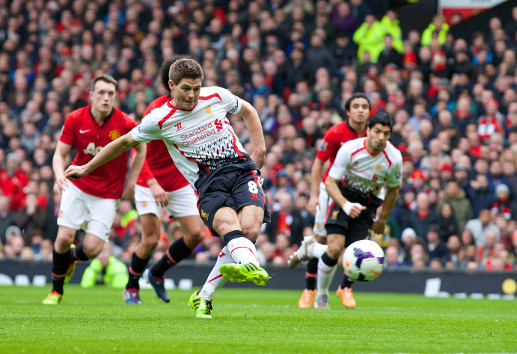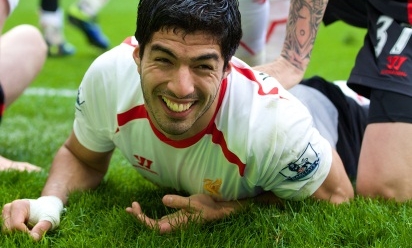Five key areas that decided United duel
From front to back on Sunday, Liverpool were at maximum levels of performance to down Manchester United 3-0 – but what were the key factors in a triumph to live long in the memory?
The personification of coolness, Reds captain Steven Gerrard perfectly placed a pair of penalties beyond the reach of David De Gea, before watching a third spot-kick strike the woodwork.
It mattered little, however, when Luis Suarez racked up a 25th Barclays Premier League goal of the campaign by collecting a low Daniel Sturridge shot and instantly side-footing into the back of the net.
In claiming another magnificent three points, Brendan Rodgers' side reclaimed second position in the standings; they now trail leaders Chelsea by four points with a game in hand on the Londoners.
How did they do it? We have picked out five areas which we believed to be crucial in deciding the encounter at Old Trafford - and we would love to hear your personal opinion in the comments section below.
The dominant display of Steven Gerrard
Rodgers' forward-thinking decision to drop his skipper into a deeper role midway through January has proven a masterstroke with each passing week, and never more so than against United. His was a performance which contained everything: supreme distribution, diligence in protecting the back four, the leadership to inspire those around him and, of course, the composure to successfully take two penalties in the maelstrom of what is still regarded as the biggest match in English football. Tangibly, the brace increased Gerrard's tally for the campaign to double figures; perhaps more crucial, though, was the 33-year-old's influence on the group of players around him. Nobody wanted it more.
A sparkling diamond formation
'Tinkering' is a word with negative connotations in the world of football, but subtle alterations to personnel (see below) and systems have brought rich rewards for Rodgers in 2013-14. His side have fluctuated between various formations, including 4-3-3, 4-4-2, 3-5-2 and, most recently, a fluid and inventive diamond set-up. Such was its effectiveness in pulling apart Southampton at the beginning of March, the boss kept faith with a similar shape in midfield - Gerrard at the base, Joe Allen and Jordan Henderson shuttling on either side and Raheem Sterling probing and running at the top. On Allen and Henderson, Rodgers explained: "The tactical intelligence of both to play on the side of a diamond, with Steven just in behind controlling and dictating the tempo, was very good."
[OTPA_WIDGET_CONTENT]
Simon Mignolet's crucial stop before the break
Although the travellers were totally dominant at the home of their rivals, their initial lead was seriously threatened before half-time, when Wayne Rooney wasted no time in taking a cross from the right flank and powering it towards the Liverpool goal with his trademark accuracy and gusto. An instant response to Gerrard's opener may have altered the course of proceedings, and when the strike left the Englishman's boot, there was baited breath among the away fans' section positioned to the right. Simon Mignolet had other ideas, however, and the Belgian's reflex response - sprawling to the side - ensured that a lead was not only carried into the break but could be built on further in the second period.
Reintroducing Sterling to the side
Rodgers made just one switch to his Liverpool starting XI for the trip to United, introducing the worrying pace and athleticism of Sterling for the guile and vision of Philippe Coutinho. Post-match, the Northern Irishman analysed the move thus: "Manchester United's centre-halves drop off, so we could exploit the space in front of that with Raheem's speed and then introduce Philippe to the game. We worked it the other way against Southampton, where we felt that we could play through and get it into Philippe, who could then open the game up, then bring Raheem into it later when it opens up." The plan was seamless; the 19-year-old tormented the Red Devils before his Brazilian colleague joined the action and quickly created two chances for his teammates in his 18 minutes on the field.

Penalty prowess in 2014
The Reds won three penalties at Old Trafford yesterday and could arguably have had at least one more; but, nevertheless, the trio they were awarded increased the total number of Liverpool spot-kicks in the calendar year of 2014 to nine. The statistic stands in stark contrast to the 2012-13 season, when Rodgers and his players had to wait until Boxing Day before being handed an opportunity from 12 yards. "We're a team that gets penalties because we're so aggressive in our attack," the manager reflected afterwards, and the evidence had been there - Suarez's intent to get into the penalty area, a driving run by Allen into the United box and a rapid dribble and desire to beat a defender by Daniel Sturridge drew the three errors by Sunday's opponents.



